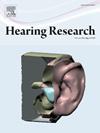Structural brain pattern abnormalities in tinnitus with and without hearing loss
IF 2.5
2区 医学
Q1 AUDIOLOGY & SPEECH-LANGUAGE PATHOLOGY
引用次数: 0
Abstract
Objective
Subjective tinnitus often coexists with hearing loss, and they share common pathophysiological mechanisms. This comorbidity induces whole-brain gray matter volume (GMV) alterations, manifesting as distributed structural changes in neural networks rather than isolated regional modifications. Multivariate analysis of structural brain patterns is therefore essential to differentiate their underlying mechanisms.
Methods
Fifty tinnitus patients and 50 age-/gender-matched controls underwent structural MRI and audiometry. Patients were stratified by hearing level into 22 with hearing loss (T+HL) and 28 without (T-HL). To investigate structural brain patterns specific to tinnitus and hearing loss, Source-Based Morphometry (SBM), a multivariate analytical approach based on Independent Component Analysis (ICA), was applied to identify covarying patterns of GMV. The associations between these structural covariance patterns and clinical characteristics were examined using Spearman's correlation analysis.
Results
Our results showed that in T-HL patients, structural abnormalities in the medial prefrontal cortex, precuneus, and auditory cortex were negatively correlated with tinnitus distress. In contrast, in T+HL patients, abnormalities in the insular structural brain pattern were negatively associated with depressive symptoms.
Conclusions
Our findings revealed that tinnitus-related structural brain patterns involve regions such as the middle frontal gyrus, supplementary motor area (SMA), and anterior cingulate cortex (ACC), with these changes negatively correlating with tinnitus distress, suggesting adaptive mechanisms in tinnitus perception. Moreover, the structural brain pattern involving the insula, putamen, and superior temporal gyrus appears to be primarily driven by hearing loss. These findings support audiometric-based subgrouping in tinnitus management.
伴有或不伴有听力损失的耳鸣的脑结构模式异常
目的主观性耳鸣常与听力损失共存,两者具有共同的病理生理机制。这种共病引起全脑灰质体积(GMV)改变,表现为神经网络的分布结构改变,而不是孤立的区域改变。因此,大脑结构模式的多变量分析对于区分其潜在机制至关重要。方法对50例耳鸣患者和50例年龄/性别匹配的对照组进行结构MRI和听力测量。根据听力水平将患者分为22例听力损失(T+HL)和28例无听力损失(T-HL)。为了研究耳鸣和听力损失特有的脑结构模式,采用基于独立成分分析(ICA)的多变量分析方法——基于源的形态测定法(SBM)来识别GMV的共变模式。使用Spearman相关分析检查这些结构协方差模式与临床特征之间的关联。结果在T-HL患者中,内侧前额皮质、楔前叶和听觉皮质的结构异常与耳鸣窘迫呈负相关。相反,在T+HL患者中,岛状结构脑模式的异常与抑郁症状呈负相关。结论耳鸣相关的脑结构模式涉及额中回、辅助运动区(SMA)和前扣带皮质(ACC)等区域,这些变化与耳鸣痛苦呈负相关,提示耳鸣感知的适应性机制。此外,涉及脑岛、壳核和颞上回的脑结构模式似乎主要是由听力损失驱动的。这些发现支持耳鸣治疗中基于听力学的亚组。
本文章由计算机程序翻译,如有差异,请以英文原文为准。
求助全文
约1分钟内获得全文
求助全文
来源期刊

Hearing Research
医学-耳鼻喉科学
CiteScore
5.30
自引率
14.30%
发文量
163
审稿时长
75 days
期刊介绍:
The aim of the journal is to provide a forum for papers concerned with basic peripheral and central auditory mechanisms. Emphasis is on experimental and clinical studies, but theoretical and methodological papers will also be considered. The journal publishes original research papers, review and mini- review articles, rapid communications, method/protocol and perspective articles.
Papers submitted should deal with auditory anatomy, physiology, psychophysics, imaging, modeling and behavioural studies in animals and humans, as well as hearing aids and cochlear implants. Papers dealing with the vestibular system are also considered for publication. Papers on comparative aspects of hearing and on effects of drugs and environmental contaminants on hearing function will also be considered. Clinical papers will be accepted when they contribute to the understanding of normal and pathological hearing functions.
 求助内容:
求助内容: 应助结果提醒方式:
应助结果提醒方式:


